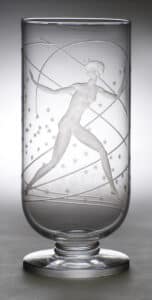
The exhibition American Art Deco: Designing for the People investigates a dynamic period in American history and culture when the country and its citizens went through political, economic, social, and artistic transformation and revolution. From stylish decorative art objects to products of industrial design, modern American paintings to compelling photographic images, the multi-media works of art in this exhibition reflect both the glamour and optimism of the 1920s and the devastation and escapism of the 1930s.
This exhibition offers an overview of an international style that manifested stateside in decorative arts, fine arts, architecture, and design during the 1920s and 1930s. Featuring approximately 140 objects, American Art Deco explores the movement between 1918 and 1939 and highlights not only the glamour and optimism of the 1920s, but also the impact of the Great Depression in the 1930s. An array of works, from a stunning 1925 René Lalique glass vase to a 1930 Ford Model A, will immerse guests in this period of much social, political, and cultural change.
The major lender to this traveling exhibition is Kirkland Museum of Fine & Decorative Art in Denver, Colorado. Key loans from Kirkland Museum join loans from Fisk University Galleries and John Hope and Aurelia E. Franklin Library at Fisk University in Nashville, Tennessee; Kansas City Museum in Missouri; Sheldon Museum of Art, University of Nebraska-Lincoln; and several private collections along with objects from the collections of the Nelson-Atkins and Joslyn for this special exhibition.
This touring exhibition is scheduled to run through February of 2023 at a few museums after starting its tour at the Frist Art Museum in October of 2021.
Art Deco
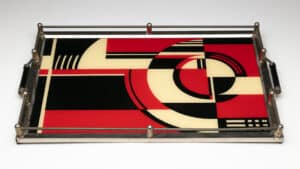
Art Deco, short for arts décoratifs, took its name from the Exposition Internationale des Arts Décoratifs et Industriels Modernes, held in Paris in 1925. The international exposition celebrated a new style characterized by geometric ornament, symmetry, stylization, and angularity, which developed globally with different variants. In the United States, it combined modern style with an embrace of materials used in industry and new technologies, influencing the design of everything from skyscrapers and automobiles to clothing and radios.
For many, the words Art Deco conjure images of soaring skyscrapers, sleek automobiles, and luxurious household items. Geometric forms and streamlined ornamentation characterize this international style, which emerged in France after World War I and quickly manifested stateside in a broad array of decorative and fine arts. This exhibition examines how Art Deco was adapted during a pivotal moment in American history, encouraging us to consider the optimism and glamour of the Roaring Twenties, along with the environmental and economic devastation of the 1930s.
The period between the world wars was a time of great social, political, and cultural change in America. Hundreds of thousands of African American families left the South for economic opportunities and hopes of racial equity; most women won the right to vote; and innovations in materials and production made new artistic designs widely available, thereby allowing more people to furnish their homes with the latest goods. At the same time, African Americans, Indigenous people, women, and immigrants faced discrimination.
One hundred years later, the changes and challenges of the interwar years can shed light on our contemporary world. There were great disparities in wealth and opportunity, as well as systemic oppression at the intersections of race, ethnicity, gender, and class. People were learning how to navigate life again after a devastating pandemic. Also, like today, many Americans hoped for a more equitable future when all would flourish and their voices would be heard – a hope expressed in many of the works on view.
From Paris to America
The ambitious 1925 Exposition Internationale des Arts Décoratifs et Industriels Modernes (International Exposition of Modern Decorative and Industrial Arts) was a potent sign that Europe was recovering from the economic, physical, and social devastation of World War I. Held in Paris—considered the world’s most fashionable city at the time—the exposition and the participating designers rejected historical styles and promoted modern architecture, interior design, and household goods with simplified lines and geometric forms, often made using precious materials. Design critics derived the name for this new style from the title of the exposition, dubbing it Art Deco.
Although American designers did not exhibit their work in the Paris Exhibition, wealthy patrons and representatives of manufacturers traveled from the United States to see the latest fashions, and many bought beautiful and expensive souvenirs. Americans who stayed home could read about the objects on display in magazine and newspaper articles. Some businesses in the United States imported French Art Deco objects similar to the examples seen in the Exhibit.
American Art Deco
New materials and technologies were key to the development of Art Deco in the United States. In American-made products, the luxurious materials used by European manufacturers were often replaced with industrially produced alternatives. Recently invented plastics replaced ivory. Aluminum, steel, and chrome dazzled like silver. Inexpensive woods, such as maple and walnut, were stained to look like mahogany and ebony. As a result, more Americans could afford the new style and update their homes while supporting postwar commerce.
Many designers in the United States favored a modern outlook that embraced industrial and technological progress. They employed abstract designs and stylized forms to symbolize a dynamic future. This attitude was reflected in everything from skyscrapers and automobiles to clothing and radios. Inspired by contemporary European artistic movements, painters and printmakers also adopted these formal elements, as seen through works in this section by Paul Manship, Raymond Jonson, and Rockwell Kent.
An Architectural Era
Following World War I, industrial cities like Chicago and New York boomed. New skyscrapers marked the peak of the Art Deco style in the United States, becoming some of the tallest and most recognizable buildings in the world. Wealth from such commercial enterprises as petroleum drilling, organic chemistry, and railroads allowed business executives to commission towering buildings made of steel and concrete. The exteriors were decorated with allusions to specific industries—lightning bolts for electricity, tires for automobiles, gas wells for petroleum. Lobbies were lavishly lined with imported marbles, silver and gold lighting fixtures, and dark mahogany furniture. Everything proclaimed power and success. Federal buildings were often constructed in the Art Deco style as well, and the Frist Art Museum, housed in Nashville’s former postal headquarters, exemplifies the aesthetic in the Grand Lobby.
To allow light and air to reach street level, civic leaders mandated the use of setbacks, or steplike tiers, at the top of skyscrapers. Architects soon adopted this form as a symbol of modernity and often topped skyscraper setbacks with spires and towers that recalled famous European churches. They were building cathedrals to commerce.
Status and Design: Hood Ornaments
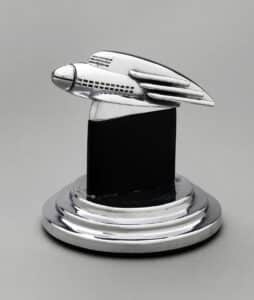
Renowned designers and manufacturers produced these hand-cast and intricately detailed accessories to adorn automobiles. Hood ornaments often thematically evoked speed and modern technological progress through motifs like airplanes or leaping horses. The French designer René Lalique crafted pressed-glass mascots after falcons and dragonflies to embellish luxury cars. In 1926, General Motors introduced a line of cars produced in Pontiac, Michigan, and manufactured a series of hood ornaments referencing the Odawa chief Obwandiyag, called Pontiac by white colonizers. Although small in scale, hood ornaments were among the most striking examples of Art Deco design in the 1920s and 1930s.
The New Woman
World War I was a turning point for American society. Women went to work—not only in direct support of the war, but also to fill thousands of job vacancies and maintain industrial and agricultural production. For the first time, a substantial number of middle-class women worked outside the domestic sphere, assuming roles as doctors, factory workers, nurses, secretaries, and more.
When men returned home from the front, many women did not want to sacrifice their independence. Galvanized by a glimpse of equality, more women advocated for their constitutional rights. On August 18, 1920, after the Tennessee legislature cast the last vote needed to ratify the Nineteenth Amendment, the federal government prohibited states from denying citizens the right to vote on the basis of sex. African American, Asian American, Hispanic American, and Native American women, however, remained disenfranchised. The fight for full voting rights and equity continues today.
Women also battled traditional restrictions with trailblazing fashion. In the 1920s, young women across racial boundaries styled themselves as flappers. Dressing for freedom (and energetic dancing), they bobbed their hair, discarded their corsets, wore looser dresses with shorter hemlines, and painted their lips with bright colors.
The Jazz Age – A Culture of Change
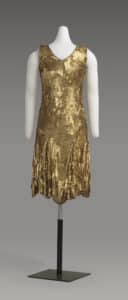
by Amédée in Paris, France features sequins over silk and net,
40 1/2” x 14 1/4” for the new slim silhouette of the 1920s Kansas City Museum, Kansas City, Missouri
Sidecars, bee’s knees, Count Basie, the jitterbug, the Charleston – these all evoke the swinging 1920s and 1930s in America. Art Deco objects and interiors with polished, mirrored, and gilded surfaces projected glamour and prosperity, even during a time of great contradictions. From 1919 to 1930, Prohibition declared that “intoxicating liquors” were illegal. Drinking alcohol went underground and behind closed doors, becoming even more fashionable.
Clubs sprang up. Dance halls, cabarets, and vaudeville acts blossomed. Jazz and the blues, both of which had originated in the African American South, attracted diverse audiences. Jazz could be thunderous and quiet, dark and often hopeful.
Although there was some social mingling of Black and white Americans, it was still a period of great segregation and inequity. In many cities, Black bandleaders could play for white people but not stay in the same hotels as their audience. Drag shows allowed for non-traditional articulations of gender within the confines of cabarets. Meanwhile, queer expression, breaches of segregation, and other violations of the convention were still widely rejected across America.
Economic Depression and Stimulus
Americans suffered great economic hardships following the stock market crash of 1929, which halted industry and the growth of wealth. The dust bowl of 1930-36 added to the misery, especially in the Midwest. Destructive agricultural practices, compounded by massive drought, destroyed the ecology of the American prairies, and food was scarce.
Recovery began in 1933, facilitated by President Franklin D. Roosevelt’s New Deal, which included a series of federal programs, financial reforms, and regulations. Public works projects constructed bridges, roads, and civic buildings. The government employed artists to document American life and decorate public spaces. Cities and businesses staged world’s fairs to encourage consumers to purchase new objects, putting designers and factory laborers back to work.
To escape the realities of the world, many people turned to movies, radio programs, and musical recordings. By the 1930s, films had sound, and comedies, westerns, and musicals were produced in great numbers. Radio broadcasts included everything from religious sermons to soap operas, to quiz shows. Big bands with bandleaders like Duke Ellington and Cab Calloway provided music for dances that went on for hours. Paradoxically, the arts flourished during this time of crisis.
Depression Glass
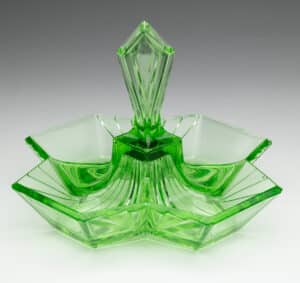
“Depression glass” is machine-made glassware produced from the late 1920s through about 1940. The moderately priced, mold-made glass was marketed to middle-class housewives in a wide variety of patterns and colors, offering a bit of brightness and hope for the dining table during the Great Depression. Some manufacturers included a small piece of glassware in boxes of food or cleansers, enticing consumers to purchase more pieces for their table service. Local movie theaters even gave away pieces of glass with the purchase of a ticket. Entire sets could be assembled in this manner.
Modern Living
As Americans recovered from the Depression, industries sold consumers a vision of the future full of gleaming household appliances like electric refrigerators and vacuum cleaners, mirrored radios, and sleek automobiles. Industrialization and technological advances in mass production made more goods accessible to a greater number of consumers, and labor-saving appliances also gave women more time to work outside the home or pursue leisure activities. New fashions, produced by large clothing factories, provided the latest styles to more people, allowing freedom of personal expression. Print and radio advertisements touted “the new” to ensure that “the old” became
obsolete and unfashionable. The United States seemed to be speeding into a bright future full of progress.
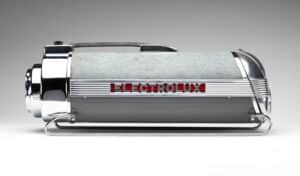
The influx of scientists, designers, artists, and writers from Europe helped to spur economic recovery in the United States, yet many of these innovators were fleeing persecution and intolerance in their homelands. Unresolved racial and economic inequities in America, including segregation in the South and redlining banking practices throughout much of the country, were also becoming even more exposed and stark. The country’s optimistic outlook was about to be challenged again: a global war and internal conflicts were on the horizon.
Streamline Moderne
During the 1930s, advances in electricity, petroleum refining, chemistry, and building materials encouraged new forms of communication and transportation. Engineers conceived sleeker, rounder, and more aerodynamic trains, planes, and automobiles, allowing for greater fuel efficiency. Designers also looked toward function and performance, removing excess ornamentation in favor of the streamlined aesthetic of the machine age. Architects applied these principles to buildings, especially commercial structures like airport terminals, gas stations, motels, and movie theaters. Industrial designers added curved forms and polished surfaces to furniture and household appliances. This new version of the Art Deco style, called Streamline Moderne, was promoted at the Chicago World’s Fair of 1933.
Visit This Exhibition
Art Deco: Designing for the People will be on display at the following museums in 2022:
Frist Art Museum, Nashville, TN, through January 2, 2022
Wichita Art Museum, Wichita, KS, February 12, 2022 through May 30, 2022
The Nelson-Atkins Museum of Art, Kansas City, MO, On View July 9, 2022 through January 8, 2023





Related posts: